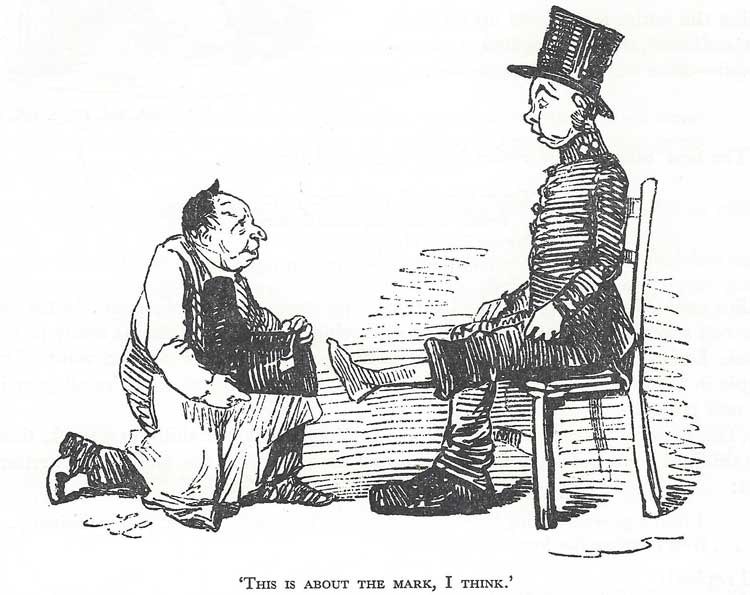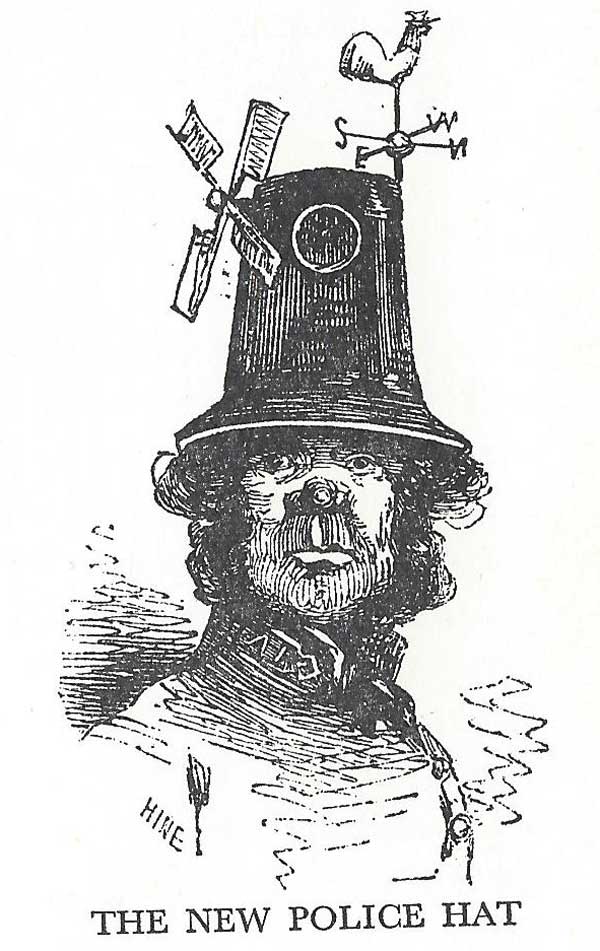Since the founding of the force by Sir Robert Peel in 1829, the Metropolitan Police underwent several changes in the style of their uniform throughout the 19th century.
As far as Robert Peel was concerned, it was imperative that this new force be clearly distinguishable from the military, and thus the early policemen headed out on their beats dressed in blue swallow tail coats (as opposed to red military-style jackets) with high collars to protect them from danger of being garroted by those they might encounter as they went about their duty of enforcing law and order. They wore white trousers and a cane-reinforced top hat which, ingeniously, could be removed in order that it might be used as a step to enable the officer to be able to climb over or look over walls!
However, by the 1840’s it was becoming apparent that, when it came to comfort, the standard-issue policeman’s uniform left an awful lot to be desired.
TWO SIZES OF BOOTS
In 1844, the Metropolitan Police advertised for tenders to supply the force with boots. This caused Punch to observe that:-
“Policemen’s boots are of two sizes only, the too small and the too large. The latter class are by far the most numerous; so that it is easy to judge a policeman by his foot, which seems twice as big as anybody else’s. These boots, or rather boats, presumably consist of leather; but they look as clumsy, awkward and inflexible, as if they were made of cast-iron….”
The article was accompanies by an illustration showing a barefoot policeman being fitted with a regulation boot.

THE POLICEMAN’S HAT
However, the item of apparel that elicited the largest number of comments in the newspapers of the 1840’s was the top hat which, according to Punch:-
“…has been compared to a chimney pot, wherefrom, however similar to it in shape and weight, it differs in the important particular of not allowing the heat and exhalations, which ascend into it, to escape…”
Indeed, in April 1844, in response to an official proposal to provide ventilation in the top hats worn by police officers, Punch presented its readers with an idea of how the new “air-conditioned” top hat might look.

A NEW HAT FOR THE POLICE
On the 4th April 1844 The Morning Post contained a tongue-in-cheek report:-
“The metropolitan police are undoubtedly a fine body of men, and very useful in their degree. They are young, active, and for the most part intelligent, nor have they ever manifested any tendencies that might impair their efficiency, except, perhaps, the occasional display of certain ebullitions indicative of a somewhat ardent temperament in both love and war.
The former shows itself when the shades of eve are “gently stealing” over the area steps that lead to the kitchen of the beloved one (for the propensity of policemen for cooks and housemaids has become proverbial); and the latter is exhibited in the street rows, when the baton of office is transformed into a weapon of offence, administering justice with a heavy hand, on the heads of knocker twisters, medical students, and other erratic “gents.”
A TRIFLING DEFECT
This trifling defect in their moral organisation has long occupied the attention of the Home Secretary and the police commissioners, and a remedy has at last been devised – simple, mechanical, and, without doubt, effectual.
It is nothing less than the invention of a new hat, which, while it protects the wearer from the summer’s heat and winter’s cold, serves at the same time to curb his impetuosity, restrain his ire, moderate the furor of his affections, and endow him with that enviable condition of mind so necessary to all who, “with a leaven’d and prepared choice,” are selected to exercise the functions of “the demigod authority.”
If, as has been truly said, there is “wisdom in the wig,” there can be no doubt but much virtue may lie under the hat, when the hat itself is made the medium by which it is communicated.
AN ALTERATION
To keep the head cool was therefore a desideratum in the policeman’s morale, and it is satisfactory to think, as the following paragraph now in circulation will show, that it has happily been attained.
The paragraph runs thus :—
“The commissioners of police have decided on an alteration in the hats of the police, which will be immediately adopted throughout the force, and which will tend materially to add to the ease and comfort of the men when on duty, especially in hot weather.
The alteration about to be adopted consists of a perforated button, affixed on each side of the hat near the crown; the hat having also an eyelet hole where the buttons are so as to admit air, and thus keep the policeman’s head cool.”
A VARIABLE CLIMATE
It may perhaps be a question, considering the variable nature of our climate and the prevalence of cold weather especially during the months miscalled hot – whether the “ease and comfort of the men” will, in reality, be secured by drilling a hole in each man’s hat to let in the east wind; but whatever physical discomfort may ensue will be more than counter-balanced by the moral effect produced.
A cool-headed policeman is “a dish fit for the gods;” endowed with coolness he becomes at once “the most senseless, and fit to bear the lanthorn;” he no longer lacks any attribute of efficiency; the perforated button in his hat will, by keeping him cool, prevent his heart from being perforated by the arrows of the little god of love; the breath of Aeolus, reaching him through his eyelet-hole, will whisper moderation in the use of the bludgeon; a transformation will be wrought in his character solely by the virtues of ventilation.
Since the days of Pyramus and Thisbe, no “chink” under the influence of “moonshine” ever rendered such valuable service.
GENERALLY ADOPTED
It is to be hoped that this plan for cooling the head will be generally adopted.
It might be serviceable on the magisterial bench as well as at the station-house; at the meetings of the League – or in the House of Commons, where legislation always sits with its hat on…”
NEW HATS FOR THE POLICE
The Cambridge Independent Press had this to say about the new headgear in its edition of the 6th April 1844:-
“The Commissioners of Police have decided on an alteration in the hats of the police, which will be immediately adopted throughout the force, and which will tend materially to add to the ease and comfort of the men whilst on duty, especially in hot weather.
The alteration about to be adopted consists of a perforated button, affixed on each side of the hat, near the crown; the hat having also an eyelet hole, where the buttons are affixed, so as to admit air, and thus keep the policemen’s heads cool.
Several of these new “ventilating” hats were served to the men last week, and they seem pleased at the improvement.”
NO PROTECTION FOR THE HEAD
However, by the 1860’s, it was becoming apparent that even this new “ventilated” top hat was insufficient for the needs of an active and modern police officer.
As The Framlingham Weekly News observed on September 5th 1863:-
“The present style of hat is no protection for the head, and it is either knocked, or it falls off, whenever the wearer is engaged in a “row.””
Punch also commented that:-
“The objectionable peculiarities of the Policeman’s hat, are chiefly its extreme hardness and excessive weight, which is the greatest at the crown, so that it gets instantly knocked off in a row. By night the glimmer from the silvery moon, or the refulgence of the gas-lamps, is reflected by his glazed hat cover and enables thieves to recognise him at a distance.”
THE NEW HEADGEAR
With the call having gone out to completely revamp the style of the policemen’s headgear, Punch decided to treat its readers to some suggestions as to how the new hats might look.
BEER-JUG AND FLOWER-POT
The first two illustrations were of a “Beer-Jug” styled hat and a “Flower-Pot” styled hat.

DINNER-BELL AND CHINA TEA-SAUCER
The next two showed the “Dinner-Bell” and the “China Tea-Saucer.”

THE CAT AND THE SAUCEPAN
The final suggestion was accompanied by a much longer explanation:-
“Is there no feeling for Art at Scotland Yard, or is it necessary that the Human Form Divine be rendered hideous as well as insolent? Who would like to be ‘moved on’ by such an absurdity? A noble classic Helmet, with vizor, ear flaps, and a highly ornamental cat on top, would have been better; or if COMMISSIONER MAYNE is really and truly wedded to ugliness, he need not have gone further than the ‘pot-board’ in his own back kitchen, the old iron saucepan is always ready to his hand.

A NEW IMPROVED HELMET
The headgear that was, in fact, adopted was, as the The Framlingham Weekly News reported “helmet-shaped” and “light, and sits firmly on the head.”
It is of course the type of headgear that we see the police wearing in all the illustrations that depict the Jack the Ripper murders, albeit the newspapers still showed concern for the fact that the wearers were out in all weathers.
Indeed, in 1872, Judy – with an illustration that was ahead of its time (if you’ll pardon the pun) – treated its readers to an illustration depicting an “Improved Helmet for the Force.”

Evidently, as far as the Victorian press were concerned, when it came to headgear, a policeman’s lot should be a happy, comfortable and dry one!
